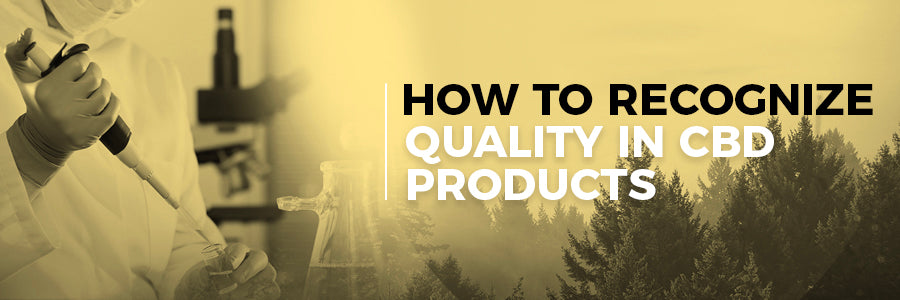How to Recognize Quality in CBD Products
The CBD oil industry is gaining traction across the country and with it, an increase in the demand for CBD products. With this type of growth in CBD suppliers, you will find that not all products are created with the same quality.
Because of this, it is extremely important to be able to identify a quality CBD product from one that is manufactured to a lower standard.

Things to be aware of in low quality CBD includes: contamination and products with little to no CBD. This could be due to heavy metal contents existing in low quality, careless manufacturing practices and untested products by 3rd party labs.
Brand Reputation and CBD Operations
The first thing to look for when selecting a CBD product is the overall reputation of the brand. Before you purchase from a brand, make sure that the brand’s online reputation is positive. Consumer reviews can disclose truths regarding brand reputation.
The Importance of Brand Quality
The ideal CBD brand will post a “COA” certificate of authorization online for every batch, offering consumers full transparency into the product. This is a sign of a reputable brand making a high-quality product.
Brands that do not list their 3rd party results may do so for a reason and typically it is not a valuable reason for the consumer other than the CBD company hiding potential contaminants, heavy metals, or pesticides.
The COA online will shed light on the specifics of what is actually in the product and can be produced for every batch. A COA will show terpene and cannabinoid profiles in the product along with testing for other harmful chemicals.
Hemp seed oil vs. CBD and how it affects quality.
When shopping for CBD, it's also important to know that hemp seed oil is not the same as CBD oil. There is NO CBD in hemp seed oil. The hemp oil listed on some product labels are commonly mistaken with CBD, but hemp oil does not contain CBD at all.
CBD is extracted from the flowers, stems, or stalk of the hemp plant. It must undergo a certain extraction process in order to be produced in absence of contaminants. Many suppliers will use the term Hemp over CBD because of additional regulations imposed by the FDA when the term “CBD” is used on a product. They are not the same.
3rd Party Lab Testing and CBD
Make sure that 3rd party lab reports are available for you to view. These reports are done outside of the CBD manufacturer who produced the product being tested. The process is used as a check and balance system to ensure quality.
In these reports, you will find that the purity, cannabinoid, and terpene profiles are all listed. This tells consumers how much of each component is in the CBD product based on lab tested results.
The 2 spectrums and an isolate
Full spectrum, broad spectrum, and isolate CBD are also 3 things that are confused between each other and it’s important to know what they mean.
- Full Spectrum contains a wide array of cannabinoids and terpenes and has .3% or less THC in the contents.
- Broad spectrum packs in the cannabinoids and terpenes without any THC.
- CBD isolate is CBD isolated from all other cannabinoids and terpenes without any THC.
How this relates to CBD quality
Understanding this is important when reading any lab produced certificate of authenticity which reveals how much CBD and terpenes made it into the product. If the quality of the CBD is poor, there may be less CBD in the product vs what is labeled.
If the CBD product is good, the COA will reveal the same amount of CBD and other terpenes via the CBD and terpene profile and it will match the contents displayed on the product label.



